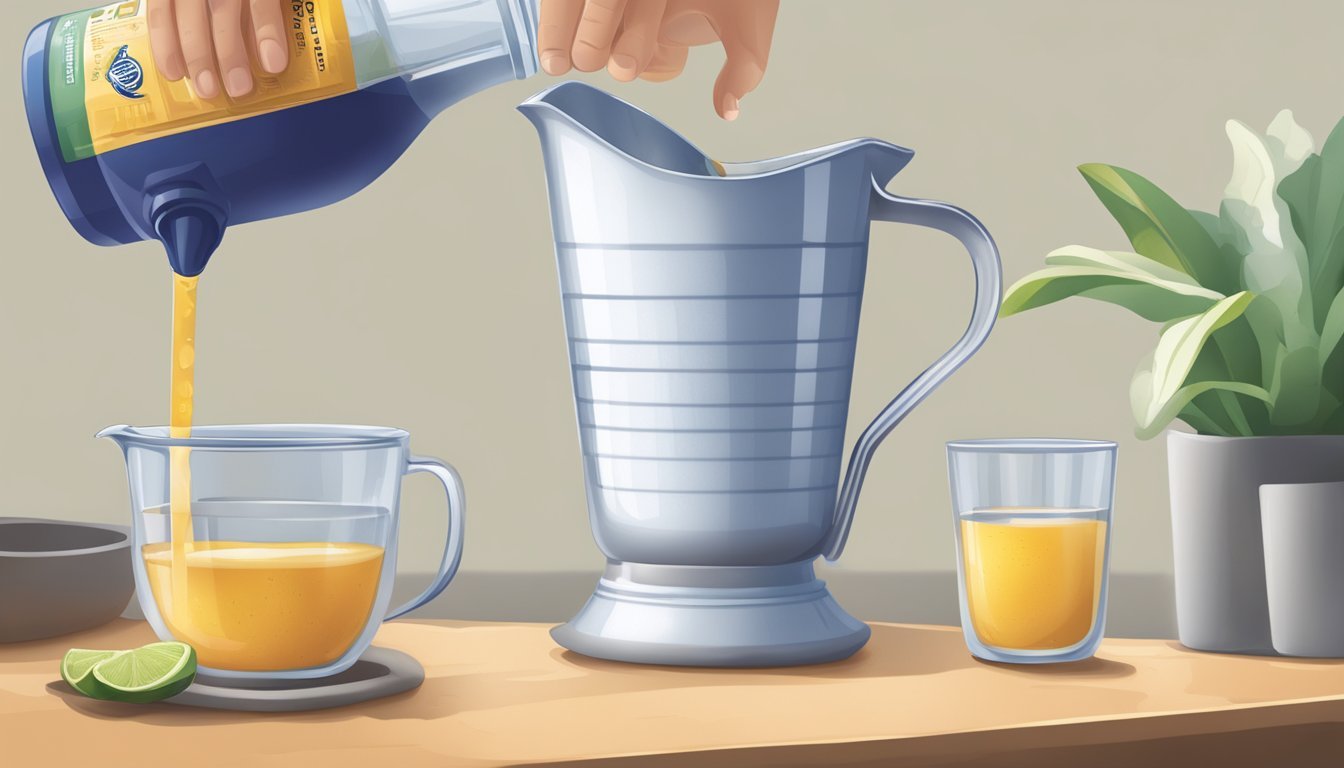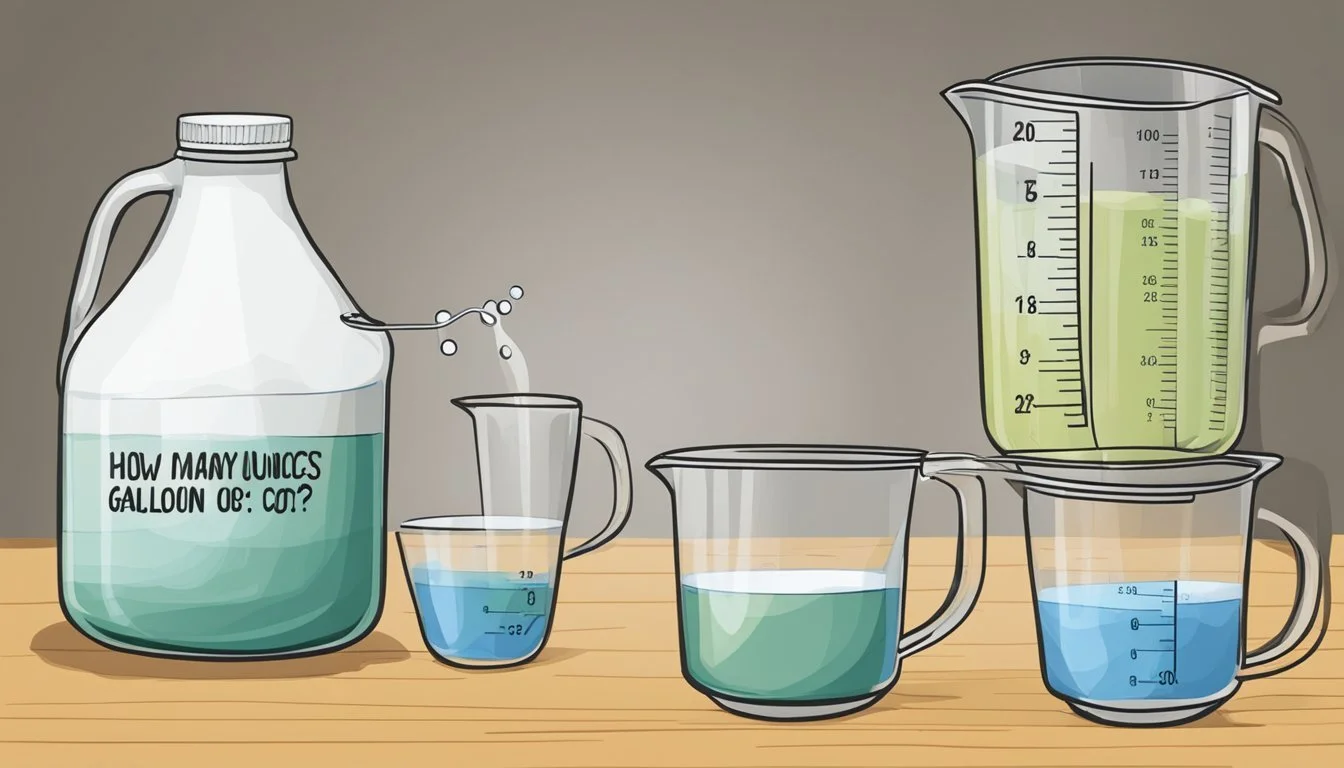How Many Ounces in a Gallon?
Quick Measurement Guide
Understanding the conversion between ounces and gallons is essential for a variety of tasks ranging from cooking to fluid measurement in scientific experiments. An ounce is a unit used to measure weight or volume, and its definition varies depending on the system applied – either the avoirdupois system for weights or the US customary and British imperial systems for volumes. In terms of liquid measurements, the US customary system is commonly used in recipes and everyday transactions.
A gallon is a larger unit of fluid measurement in the US customary and the British imperial system, with the US gallon being different from the imperial gallon. In the US system, one gallon is equivalent to 128 fluid ounces. This relationship is crucial in tasks that require precise fluid measurements like dispensing medication, culinary arts, or mixing chemicals.
For individuals involved in international trade or travel, grasping the difference between the US and imperial measurements can prevent misunderstandings or errors in recipes, manufacturing, and scientific research. It also enables one to efficiently switch between different measurement systems, which is beneficial given the varying standards used around the world.
Understanding Volumes and Units
In measuring volume, it's essential to use the correct units and understand their relationships. Precise conversions between different volume units are key for accuracy in various contexts, from cooking to scientific measurements.
Volume Basics
Volume is a measure of the space occupied by a substance or object. It is a key concept in fields ranging from chemistry to everyday cooking. The standard unit of volume in the United States is the gallon, which can be converted into other units such as ounces for smaller measurements.
Unit Definitions
Gallon (gal): A unit of volume primarily used in the United States. One gallon equals 128 U.S. fluid ounces or about 3.785 liters.
Unit Equivalent 1 U.S. Gallon 128 U.S. Fluid Ounces 1 U.S. Gallon 3.785 Liters
Fluid Ounce (fl oz): A smaller unit of volume used for measuring liquids. In the U.S., one fluid ounce is approximately 0.0078125 gallons.
Unit Equivalent 1 U.S. Fluid Ounce ~0.0078125 U.S. Gallons
A clear understanding of these basic volume units and their definitions is critical when precise measurements are necessary.
US and Imperial Systems
When discussing volume measurements, it is vital to distinguish between the US Customary System and the Imperial System. The conversion between gallons and ounces varies significantly depending on which system is used.
US Customary System
The United States primarily utilizes the US Customary System. In this system, the standard volume unit for liquids is the US liquid gallon. One US gallon is equivalent to 128 US fluid ounces. This measure is commonly used across the United States in everyday transactions and labels.
US Gallon US Fluid Ounces 1 128 2 256 3 384 4 512
Under this system, volumes are commonly expressed in fluid ounces, which represent a small unit suitable for measuring liquid quantities.
Imperial System
Conversely, the United Kingdom adopted the Imperial System following the Weights and Measures Act of 1824. Within this system, the Imperial gallon is larger than the US gallon. One Imperial gallon equals 160 Imperial fluid ounces.
Imperial Gallon Imperial Fluid Ounces 1 160 2 320 3 480 4 640
It is essential to note that an Imperial fluid ounce is slightly larger than a US fluid ounce, reflecting the historical differences in how these two systems developed.
Unit Conversion Fundamentals
When performing unit conversions, particularly from ounces to gallons, it's crucial to understand the underlying conversion factors and formulas. These components enable accurate and efficient transitions between different units of measurement.
Conversion Factors
The conversion factor is a critical element that represents how many of one unit equals another. For converting fluid ounces to gallons, the specific conversion factor used is:
1 gallon = 128 fluid ounces (U.S.)
A conversion table can visually represent multiple conversion factors and is especially useful when dealing with a range of values. An example for ounces to gallons might look like this:
Fluid Ounces Gallons (U.S.) 32 0.25 64 0.5 96 0.75 128 1 256 2 384 3
Each row represents a fixed relationship defined by the conversion factor.
Conversion Formulas
To convert ounces to gallons, one needs a defined formula. The formula is straightforward and employs the conversion factor:
Gallons = Ounces / 128
Using this formula, they can convert any given number of ounces into gallons by dividing by 128. For example, to convert 256 ounces to gallons:
256 ounces / 128 = 2 gallons
For the reverse conversion, multiply gallons by 128 to get the number of ounces.
Practical Conversion Tools
In the realm of measurements, precise tools are paramount for converting gallons to ounces and vice versa. They facilitate error-free conversions essential for various applications ranging from cooking to chemical engineering.
Conversion Calculators
A conversion calculator is a digital resource that allows users to enter a value in gallons to instantly receive the equivalent in ounces. These calculators often feature a simple interface where one inputs the quantity next to 'gallons' and immediately gets the result in 'fluid ounces'. For example:
Input: 1 gallon
Output: 128 fluid ounces (US customary system)
It’s important to note that in the US system, one gallon equates to 128 ounces, while in the Imperial system, used mostly in the United Kingdom, one gallon equals 160 ounces. Users should ensure they select the correct system before computing.
Interactive Conversion Aides
Interactive conversion aides, such as interactive slide bar converters, enhance user experience by offering a fluid and dynamic method for measurement conversion. Users can adjust a slide bar to the desired quantity in gallons and observe the conversion to ounces occur in real time. This tactile approach can aid in visualizing the relationship between the two units of measure, making it advantageous for educational purposes or quick estimations.
Some websites provide these interactive tools with additional features such as:
Converting back and forth between units by simply toggling an option.
Automatic unit detection based on the entered value.
Interactive conversion aides and calculators are particularly useful for tasks requiring precision and ease, and they are widely available on various websites and mobile applications.
Volume Conversion Details
When dealing with liquid measurements, particularly in recipes or chemical mixtures, converting between gallons and ounces is a fundamental skill. The conversion process is essential for accuracy in both personal and professional settings.
Gallons to Ounces
To convert gallons to ounces, one must understand that a single US gallon contains exactly 128 US fluid ounces (fl oz). Therefore, to convert gallons to fl oz, one multiplies the number of gallons by 128.
1 US gallon = 128 US fluid ounces
Conversion Table:
Gallons (US) Fluid Ounces (US) 1 128 2 256 3 384 4 512 5 640
Ounces to Gallons
For the inverse conversion, converting ounces to gallons, one should divide the number of ounces by 128 since one US gallon is the equivalent of 128 US fl oz.
1 US fluid ounce = 1/128 US gallon
Conversion Table:
Ounces (US) Gallons (US) 128 1 256 2 384 3 512 4 640 5
In both conversions, it's critical to use the appropriate units to avoid confusion, particularly distinguishing between the US and Imperial systems, as the Imperial fluid ounce is not equivalent to the US fluid ounce.
Additional Measurements and Increments
Understanding the relationship between ounces and gallons offers a foundation for a variety of measurements used in cooking, science, and industry. This section explores additional increments that relate to gallons and fluid ounces.
Quarts, Pints, and Cups
In the United States, a gallon can also be subdivided into quarts, pints, and cups. For clarity:
1 gallon is equivalent to 4 quarts.
1 quart equals 2 pints.
1 pint is the same as 2 cups.
Therefore, one gallon contains 16 cups, which translates to 128 ounces if one cup is measured at 8 ounces.
Milliliters and Liters
The metric system measures volume primarily in liters (L) and milliliters (mL). One liter is equal to 1,000 milliliters. To understand their relation to ounces:
1 liter is approximately 33.814 ounces.
1 milliliter is approximately 0.0338 ounces.
Since 1 gallon is approximately 3.785 liters, it contains about 3,785 milliliters.
Cubic Inches and Capacity
The capacity of a gallon in cubic inches can be a relevant conversion for manufacturing and engineering contexts:
1 gallon equals 231 cubic inches.
Additionally, capacity can refer to the maximum amount that a container can hold, which is crucial for storage and transportation. A 1-gallon container has a capacity of 128 ounces, corresponding to its volume in fluid ounces.
Understanding Weight vs Volume
In the realm of fluid measurements, two critical concepts are distinct yet often conflated: mass (or weight) and volume.
Mass and Volume
Mass is a measure of how much matter is in an object, typically expressed in kilograms (kg) or pounds (lb). Volume, conversely, quantifies the space that a substance occupies, measured in liters (L), gallons (gal), or fluid ounces (fl oz). These units are crucial as they define the amount of a substance, not its weight.
Weight Conversion Relevance
Weight conversion becomes relevant when one needs to transition between mass and volume. The density of a substance is the bridge between these two measures; it is the mass per unit of volume. For fluids like water, weight and volume can be interconverted directly using typical fluid densities because their weight per volume is a known constant. For instance, one US gallon of water roughly weighs 8.34 pounds (133.53 ounces).
Volume Density Weight 1 gallon ~1 g/mL ~8.34 lb
However, this direct correlation does not apply to all substances as densities vary considerably between different materials.
Utilizing Conversion References
When converting fluid ounces to gallons, individuals often rely on references such as conversion charts and tables, which provide the necessary information arranged systematically for ease of use. These references are integral tools for accuracy and consistency in various applications, from cooking to scientific experiments.
Conversion Charts and Tables
Conversion charts and tables present the relationship between ounces and gallons in an organized manner. A common ounce to gallon conversion table may appear as follows:
Ounces (oz) Gallons (gal) 32 0.25 64 0.5 128 1 256 2 384 3
Each increment in the table builds on the basic understanding that 128 ounces equal 1 gallon. These tables are designed with various increments, allowing users to find the corresponding volume quickly. It’s important to note that for dry measurements, the conversion might differ and level of accuracy is crucial - typically, conversion tables are rounded to the nearest two to three decimal places for practical applications.
Abbreviations and Symbols
When interpreting conversion references, recognizing and understanding abbreviations and symbols is key to ensuring proper usage. In the context of liquid volume conversions, "oz" stands for ounces, and "gal" is the abbreviation for gallons. These standard abbreviations are used in many scientific and culinary settings. It is essential that users understand and use these symbols correctly to avoid miscalculations.
Using these tools correctly, one can confidently and effectively navigate tasks that require the conversion from ounces to gallons or vice versa.






